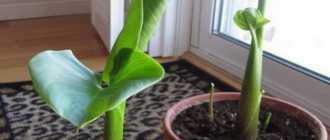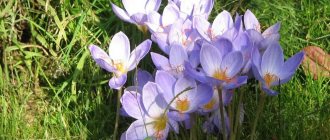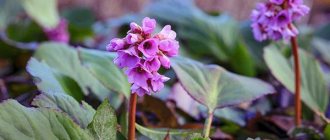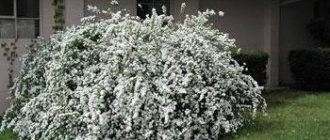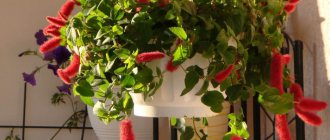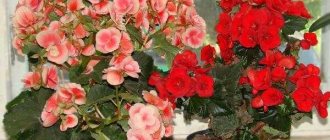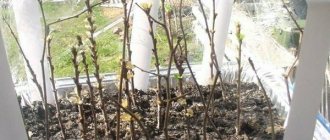Growing conditions
What do those who are planning to plant godetia and seriously engage in its cultivation and care need to know?
- This plant can hardly be called capricious. It grows well in loamy soil and does well in places that are not blown by the wind. Light partial shade will also not have a significant effect on growth.
- Until October (in rare cases until November), godetia blazes with bright colors, without even thinking about blooming.
- If you choose a tall variety, you definitely can’t do without tying it to additional supports.
- During the rainy season, it becomes defenseless and needs additional support and care.
Feeding should not be excessive! A seemingly harmless procedure can provoke vigorous growth of green mass. Much fewer buds will form.
You should also be careful with watering - dosed and periodic, but without fanaticism. Stagnation of water is unacceptable, otherwise additional drainage will have to be done. Is there a real way to somehow stimulate flowering? Periodically pick off all faded buds to stop the formation of ovaries. Otherwise, the plant may become very weak. You can also leave a couple of buds specifically to later get seeds. They are collected approximately 30 days after flowering, when the boxes have darkened. Dry it and put it in a separate bag. Good germination has been maintained for 3 years.
Godetia in the open ground
Video on how to sow Godetia seedlings
Growing bacopa from seeds
After germination of the seedlings, the polyethylene is removed and the containers are transferred to a brightly lit place. If the seeds are planted in separate containers, then picking is not performed. If sowing was carried out in containers or wooden boxes, when two true leaves grow on the seedlings, transplantation is carried out. Three sprouts are planted in a container
Transplantation is carried out with extreme caution, since the roots are not yet strong. If the root is long, it is shortened with a sharp instrument.
Planting in open ground
When the seedlings grow up to 7 cm in height, they are transplanted to a permanent place of growth. Transplantation is carried out in the last ten days of May or early June. 15 days before planting the seedlings, a hardening procedure is performed. The seedlings are taken outside, initially for two hours, and then the time spent outdoors is gradually increased. Before transplanting, the seedlings are left outside for a day.
When choosing a place for planting, you should take into account that Godetia is a light-loving plant. The flowerbed should be well lit by sunlight. If the area is shaded, there will be no active flowering and the flowers will be small. The site is prepared in advance by digging up the soil and adding humus. The amount of humus is calculated so that five kg of fertilizer is applied per square meter. To normalize the acidity level, ash is added to the soil.
Seedlings should be planted in the evening or on a gloomy day. The plants are planted, leaving 20-30 cm between the bushes. The seedlings are planted with a lump of earth in prepared planting holes, the soil around is slightly compacted and watered well.
Care
For good growth and active flowering, plants should be cared for as follows:
- Watering should be regular but moderate. The plant should not be flooded, as this can lead to rotting of the roots and the development of various fungal diseases.
- Loosening is carried out regularly. This procedure will ensure good penetration of oxygen to the root system and prevent stagnation of moisture in the soil. During loosening, weeds are removed, which impede plant growth and draw useful substances from the soil.
- Tall species of Godetia require tying to supports.
- Fertilizing is done once or twice every 30 days, depending on the fertility of the soil. For feeding, fertilizers for flowering plants or complex mineral fertilizers are used, but without excess nitrogen.
- To improve flowering, remove faded inflorescences.
Growing from seeds
One of the features of the plant is its relatively high frost resistance. Even small sprouts can withstand frosts down to -2 degrees, and a drop in air temperature down to -5. The plant is sown in a flower bed, and the seedlings are covered with film to provide protection. Sowing is carried out in mid-spring. If your area has a mild climate, sowing before winter is allowed.
In regions where there is no severe winter, godetia seeds are sown in November. Before placing the seeds in the soil, they are first disinfected and dried in the sun, in a warm place. Then all crops are covered with earth and mulched. For additional protection against frost, you can use black film or protective materials.
Traditional sowing of godetia from seeds is carried out in May. The soil is first dug up and loosened, after which it is moistened. The seed is immersed to a shallow depth - no more than 1 cm. To avoid picking, the distance between the bushes should be 25 cm. Dense plantings must be thinned out.
Growing godetia from seeds
Careless picking of godetia and improper planting can lead to the seedlings dying. Growing without seedlings is much simpler than growing from seedlings. But growing from seeds also has its disadvantages. The growing season takes several months, sometimes up to 90 days. You understand, a decent period for an annual plant. So, despite all the difficulties and risks, for the godetia plant, planting seedlings looks much preferable.
Landing dates
Seeds are sown directly into the ground if the climate in the region is warm. Possible slight drops in temperature only harden young plants.
Autumn sowing of godetia is sometimes practiced. Then the seedlings appear after the soil warms up in early May, having gone through natural stratification. For autumn sowing, use twice as many seeds as is usually required. They are mixed with washed river sand and placed in grooves at intervals of 3 cm.
In autumn, seeds are sown after the first frost. Depending on the climate, this could be early November or late October. At this time, the soil will already freeze a little and the seeds will not have time to germinate before the onset of winter. A 4 cm thick layer of peat is used as a cover for the bed. After the seedlings emerge in the spring, they are transplanted to a permanent place.
Sowing seeds depending on the region
The timing of planting godetia when grown from seeds is determined by weather conditions. In the south and other regions with mild climates, they are sown in open ground after the soil has dried and warmed to +15°C. Typically, optimal conditions for planting seeds are created at the end of April. Soon the first shoots appear. 80 days after the sprouts appear, the time for flowering begins.
Article on the topic: Which flowers can be taken outside and which cannot; caring for indoor flowers outside
In Siberia, the Moscow region and the Urals, the climate is more severe. Therefore, sowing in open ground is not practiced here. Here it is more convenient to grow godetia seedlings. Seeds are sown in boxes in mid-March. Then, by the end of May, the seedlings will have grown so much that they can be moved to the garden bed.
Sowing seeds for seedlings can be done from the end of February. But then the plants are provided with additional lighting so that the seedlings do not stretch out and are of good quality.
Sowing according to the lunar calendar: table of favorable dates
The Earth's natural satellite influences the development of all plants. Therefore, experienced gardeners recommend sowing seeds taking into account the phases of the moon. If it is growing, the movement of plant sap occurs from bottom to top. At this time, the root system is more pliable. Therefore, transplanting seedlings and sowing seeds will be successful. On the waning Moon, sap flow goes in the opposite direction. These days it is better not to sow godetia and not to do other work related to planting or replanting.
According to popular belief, it is best to plant seeds in the ground on Wednesday or Friday. These days are considered “women’s days”. On Saturday and Sunday the earth is not disturbed, as it rests.
Selecting good soil
Godetia grows on loamy soil. And at the same time, you should avoid excessive moisture. When cultivating planting material in a balcony box, take care of an additional drainage layer. The plant prefers slightly acidic soils to alkaline soils. For deoxidation, lime is used; dolomite flour is preferred. How else to eliminate an alkaline environment? You can add urea and dilute it with peat. The soil is prepared with your own hands, mixing garden soil, peat, and river sand in equal proportions.
One of the conditions for good growth of a godetia flower is planting and care in a place where the rays of the sun constantly arrive. The plant prefers dim lighting. The midday heat burns the tender petals. The best option would be areas with light shading. It is not afraid of frost, but we still recommend choosing the south side for planting seedlings rather than the north. By combining godetia with annual and perennial plants, you can achieve amazing color results.
Why not do without potassium permanganate?
When godetia is grown, planting seedlings and further care in open ground require the use of potassium permanganate. The need for its use is due to the fact that the plant is susceptible to pest damage. Therefore, a lot of attention is paid to disinfection during sowing.
Before sowing seeds, it is imperative to soak them in a solution of potassium permanganate for at least one hour.
Most often, sowing is carried out at the end of March. Take small containers up to 15 centimeters deep. For picking, it is better to use deeper pots (from 20 cm).
- Disinfect containers.
- Prepare drainage and fill in the required soil. Disinfect and moisten it. The water should be completely absorbed.
- Spread the planting material thinly and cover with a 1.5-centimeter layer of peat.
- Cover with plastic and place in a warm place.
- When the first shoots appear, the film is removed and watered until two true leaves are formed.
- Plant into pots 2-3 at a time, shortening the central root of each seedling by 1/4.
- Ready seedlings are planted in May. Please note that the plant is sensitive to all kinds of movements. Therefore, the landing procedure must be careful and always on a cloudy day.
Some gardeners are faced with the following problem: godetia seedlings have become very elongated. As a rule, this occurs due to lack of lighting or too dense sowing. There is a solution: picking, finding a well-lit place, adding additional lighting with lamps, reducing watering. A week after picking, complex fertilizer is applied.
If flowers appear, replanting is undesirable. Regularly remove weeds from the soil, lightly loosen the soil, regularly clean and fertilize with nitrophoska. For tall varieties, a support is made from twigs so that the stems do not break under the weight of the flowers.
Godetia seeds in potassium permanganate
Caring for godetia in open ground
To enjoy the blooming species of godetia, it is important to follow all the rules of care - watering, fertilizing, weeding.
Watering
Water the bushes moderately and often, while avoiding waterlogging of the soil and drought, not with cold water.
Top dressing
Depending on the composition of the soil, fertilize the plants once or twice a month. First, a week after planting in the ground. With the formation of buds, mineral complexes are added. Excess nitrogen should not be allowed; this will lead to abundant foliage growth, but the flowers will be small. They feed with Nitrophoska (12 liters of water and a tablespoon of the product), Agricola, Ideal.
Weeding
The bushes are constantly weeded to remove weeds and the soil is loosened after watering.
Formation
Withered flowers are removed and thus prolong flowering. Dried leaves are also removed, plants that are too tall are tied to supports, otherwise they will bend from the weight and look unsightly.
After flowering
Seed ripening occurs four weeks after godetia has flowered. When the seed pods darken, they are cut off, then dried, and the seeds are removed, which remain viable for 4 years. With the onset of frost, the bushes are removed along with the roots and burned so that diseases do not spread, and the ground is dug up.
Pleasant
Common Pests
The soil should not be over-moistened, otherwise the plant may develop root rot. Diseased specimens are removed and burned. In cases of peronosporosis, fungicides are used. The abundance of weeds on the site may be accompanied by the appearance of leaf-eating insects. In this regard, it is recommended to regularly maintain cleanliness, prevent the spread of weeds, and weed the soil in a timely manner.
What pests are most common? As a rule, this is an aphid, a flea beetle. The problem is solved by spraying with insecticides, a solution of ash and laundry soap. Birch tar is considered an effective remedy. It has a specific smell that repels insects.
Types, varieties of godetia
All varieties differ in leaf shape and have a unique petal shade. The height of the stem is also different. Consider the popular varieties:
- Godetia azalea flower. The flowers are large and fleshy. Suitable for decorating gardens, creating compositions on windows and terraces.
Godetia azalea flower
- Rembrandt. It is easily recognized by its flowers with wavy petals and a terry covering. The shade is pink, in the center there is a carmine spot.
- Godetia monarch is considered one of the popular varieties. Reaches 40 cm, the flowers have beautiful iridescence and are painted in different tones.
- Terry. This species does not exist in nature, but hybrid varieties often have double inflorescences.
- Meteor. Herbaceous annual plant with cup-shaped flowers up to 8 cm. Color purple, pink.
- Butterfly. A low-growing variety that blooms from July to October. The flowers are double, semi-double, but there are hybrids with wavy edges. Used to decorate flower beds.
- Orange Glory. To make the area bright and unusual, plant the Orange Glory variety on it. It is unpretentious in care, is not afraid of frost, and is characterized by long and abundant flowering.
- Red wine. It grows well in open ground, flowerpots, the flower size reaches 6-8 cm. If sown in May, Godetia red wine will bloom in August and will delight you with burgundy buds.
Godetia red wine
Other common varieties include godetia beauty, Summer Paradise, Dragonfly, Yesenia, “Lady in Blue”, etc.
Botanical description
The stems of godetia are erect, branched, reaching a height of 20 to 60 cm and forming neat bushes - spreading or pyramidal, depending on the type and variety. The leaves are alternate, lanceolate, entire. The flowers are bell-shaped or cup-shaped, quite large in size - from 3 cm to 10 cm in diameter, simple, consisting of four petals, or double - collected in a brush. The color of the flowers is white, red, carmine, peach, pink, purple, there are varieties of combined colors. Peduncles are short. The fruit is a tetrahedral cylindrical capsule in which very small seeds ripen and remain viable for three to four years.
In the photo: Striped godetia flower
In addition to godetia itself, its numerous hybrids are also used in cultivation: azalea-shaped, dwarf, terry and bushy varieties of godetia. Godetia blooms from July until frost and easily copes with temperature changes.
- Adonis: growing in the garden, types and varieties
Use in landscape design
The flower got its name in honor of the European scientist and botanist Godet. However, the true ancestors of the plant come from South America. And, it’s worth noting, they don’t look so attractive.
Are godetia seedlings used in landscape design? Undoubtedly. It can be seen in flower beds and in balcony boxes, growing in outdoor vases and flower beds. Without a doubt, no creative mixborder can do without such a wonderful flower. Miniature varieties that are planted in flower boxes and displayed on the veranda will look especially attractive. This “living border” will be a wonderful decoration for any path or flower bed.

